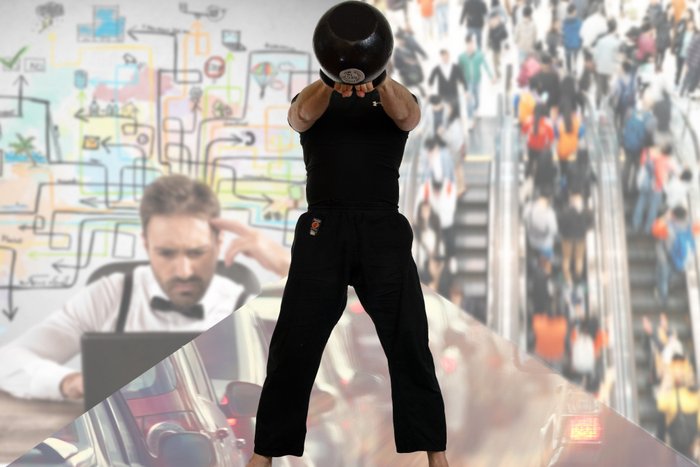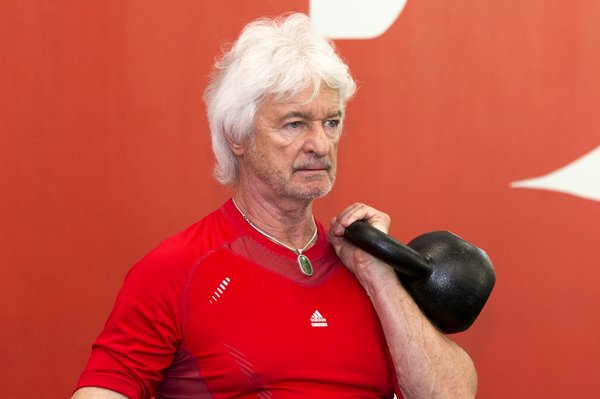
In teaching people of all walks of life, I have observed several distinct effects of kettlebell training. Some are obvious, others much less so…
If you are new to kettlebells you might be wondering what impact this new implement might have on you if you start using it consistently. This article should give you a good idea of what to expect, and it will probably strengthen your resolve to give kettlebell training a try.
On the other hand, if you are already an kettlebell expert or an HKC or RKC Instructor, you may find that you have already experienced or witnessed these effects with your clients. When I first started teaching kettlebells, it was sometimes difficult to convince potential clients or new students that kettlebells were right for them. In following paragraphs I will try to summarize my observations regarding the positive impact of kettlebell training.
Kettlebells Are Perfect For Making You Fit in a Limited Amount of Time
We all know that training promotes physical and mental health. What has changed in recent years is that science has now started to explain why. How muscles impact the immune system, or the effects of aerobic exercise on brain function are somewhat new areas of research. In the past, there was only the subjective experience of people like John F. Kennedy or Jack LaLanne who promoted an active lifestyle many years ago, but today we have profound scientific explanations for why everyone needs to move on a regular basis.
Yet, while medical science has started to understand the importance of movement for our overall health, the reality of our lives has also rapidly changed—and many people are more unhealthy than ever before.
Our lives have become faster and more stressful than in the history of mankind. To cope with this increased speed, we rely more and more on technology—therefore we’re moving less than any of our ancestors. Aside from obvious things like driving wherever possible or using escalators instead of stairs, there are more subtle changes that rob you of the opportunity to move. Internet stores make everything—even kettlebells—available at your fingertips without leaving your house.
We need movement more than ever, but we have less time and fewer opportunities for it. The average gym class or 45 minutes on the treadmill can not compensate for the lack of movement during your work-week—unless you can train several hours per day.
The kettlebell is the perfect solution for this problem. With its off-centered mass, it trains your muscles and your heart at the same time. Exercises like swings, cleans and snatches train your entire posterior chain—the group of muscles, ligaments, and tendons most important for a healthy spine and good postural alignment.
Kettlebells Naturally Improve Your Posture
Correctly swinging a kettlebell activates two muscles that are usually dormant in much of modern society: the gluteus maximus and the latissimus dorsi. These muscles are the two most important players in our posterior chain. Luckily, we can use the kettlebell to get them back into action.
The gluteus maximus (or more crudely defined, your butt muscle) is one of the biggest and strongest muscles in the body. If it functions as it should, it enables you to lift heavy objects from the ground and also protects your lumbar spine. In the kettlebell swing, its role is to forcefully lock out the hips. One of the first exercises I use with beginners when I teach the swing is the shoulder bridge (you lie on your back with your feet pulled toward the butt and push your hips to the ceiling). We start with this exercise for only one reason—so the beginners can experience what it feels like when their glutes are tensed. I rarely have my beginners do more than 30-40 swings during the first lesson and they are still sore the next day—guess where!
Active glutes lead to unlocked hip flexors and allow the pelvis to get into a neutral position, the foundation for a naturally s-shaped spine. The activation of the glutes is why sometimes even a few short kettlebell sessions can lead to an improved postural alignment.
The second muscle group, the latissimus dorsi (or the lats) is mainly responsible for all upper body pulling movements, but they also help with your press if you use them correctly. Additionally, the lats are able to stabilize the upper back and protect the shoulders.
In the swing, the lats are used to keep the kettlebell from pulling your shoulders forward and they also counter rotation in one-arm swings.
Kettlebells Bring Vigor and Youth Back
Have you ever noticed that you can accurately guess someone’s age from fairly far away by watching how they move? An older person is usually more restricted and moves gingerly. On the other hand, children move with mobility and vigor—at least until we make them sit still for hours every day.
For beginners, one of the hardest concepts in Hardstyle kettlebell training to understand is the explosive nature of the movements. We are not just standing up with the bell in hand, but are exploding out of the hinge and tensing the whole body in the top position. Movement of this quality simply does not exist in our every day lives. The average adult unlearned fast and crisp movements. With kettlebells, your body learns that it is not dangerous to move fast, and you will soon start to move as you did in your youth.
After beginners understand this idea and move more dynamically, they usually feel very good and empowered. They break the chains which have restricted their movement for years. It’s a great feeling, and you usually can see it in their eyes.
If you are wondering if this paragraph is dedicated only to a certain age group, it is not! Kettlebell training works for people in their late teens as well as for senior citizens older than 60. The only real difference is that older beginners will have more movement habits to unlearn, and will need to be more cautious in the process. A trusted RKC Instructor can be very helpful in these situations.

Kettlebells Allow You to Express Yourself
The last aspect of kettlebell training I would like to discuss in this article is breathing. When watching people train, one of the first things you will notice is their rhythmic and loud breathing. Some people, especially the ladies will be slightly appalled when confronted with this for the first time. We raised in a culture where the sounds our bodies produce are considered to be inappropriate—which is kind of weird if you think about it. Therefore we always try to avoid or conceal those sounds, so it can be shocking when you first enter a gym and see a group swinging a kettlebells and sounding like a gathering of steam engines! What a strange sight!
Deep and pressurized breathing has several positive effects on our body. Most importantly, it activates the diaphragm.
Aside from these physical effects, I also observed that we are psychologically effected. It is similar to that of the Kiai, the blood-curdling Tae Kwon Do war cry you can hear during the keykpa (board breaking). Beginners always struggle with it and feel strange to call out this loudly. It is the same with the Hardstyle breathing during a good kettlebell session, you will hear hisses, grunts and even yells. Sometimes the rhythmic sounds you hear from a group swinging and pressing together can sound like a weird kind of music 😉
When you overcome the internalized reflexes of your upbringing and allow your breath—the most fundamental function of your physical existence—to be heard, it seems to flip a switch in your brain which makes it easier to express your needs. It literally liberates you to make yourself heard.
Conclusion
If you are already using kettlebells, you will have experienced the transformative nature of this seemingly archaic training tool. I would be glad If you could find the time to share your own experiences in the comments.
If you have not yet started training with kettlebells, I strongly encourage you to give it a try. Expect it to be a humbling experience in the beginning, but know that it has the power to make you better and healthier than you are today. A good coach can help anyone get a good start. It will not be comfortable, it will not be easy, but it will definitely be worth it!
He writes a regular Blog at blog.kettlebellgermany.de and offers workshops all over Germany teaching the RKC Kettlebell exercises: KettlebellGermany.de.
If you have questions or comments on the article feel free to email him at florian@kettlebellgermany.de